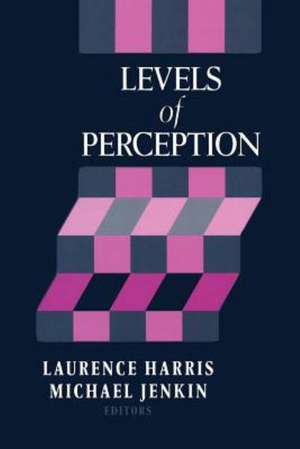Levels of Perception
Editat de Laurence Harris, Michael Jenkinen Limba Engleză Paperback – 23 apr 2013
| Toate formatele și edițiile | Preț | Express |
|---|---|---|
| Paperback (1) | 1103.39 lei 6-8 săpt. | |
| Springer – 23 apr 2013 | 1103.39 lei 6-8 săpt. | |
| Hardback (1) | 1107.94 lei 6-8 săpt. | |
| Springer – 26 ian 2003 | 1107.94 lei 6-8 săpt. |
Preț: 1103.39 lei
Preț vechi: 1161.47 lei
-5% Nou
Puncte Express: 1655
Preț estimativ în valută:
211.14€ • 220.100$ • 175.73£
211.14€ • 220.100$ • 175.73£
Carte tipărită la comandă
Livrare economică 31 martie-14 aprilie
Preluare comenzi: 021 569.72.76
Specificații
ISBN-13: 9781475778359
ISBN-10: 147577835X
Pagini: 464
Ilustrații: XXIV, 434 p. 126 illus.
Dimensiuni: 155 x 235 x 24 mm
Greutate: 0.64 kg
Ediția:Softcover reprint of the original 1st ed. 2003
Editura: Springer
Colecția Springer
Locul publicării:New York, NY, United States
ISBN-10: 147577835X
Pagini: 464
Ilustrații: XXIV, 434 p. 126 illus.
Dimensiuni: 155 x 235 x 24 mm
Greutate: 0.64 kg
Ediția:Softcover reprint of the original 1st ed. 2003
Editura: Springer
Colecția Springer
Locul publicării:New York, NY, United States
Public țintă
ResearchDescriere
In this book the authors relate and discuss the idea that perceptual processes can be considered at many levels. A phenomenon that appears at one level may not be the same as a superficially similar phenomenon that appears at a different level. For example "induced motion" can be analyzed in terms of eye movements or at the retinal level or at a much higher cognitive level: how do these analyses fit together? The concept of levels also makes us think of the flow of information between levels, which leads to a consideration of the roles of top-down and bottom-up (or feed-forward, feed-back) flow. There are sections devoted to vestibular processing, eye movement processing and processing during brightness perception. The final section covers levels of processing in spatial vision. All scientists and graduate students working in vision will be interested in this book as well as people involved in using visual processes in computer animations, display design or the sensory systems of machines.
Cuprins
1) Ian P. Howard and levels of perception I: BRIGHTNESS AND LIGHT 2) Dualistic versus monistic accounts of lightness perception 3) Levels of Brightness Perception 4) A Multiscale Spatial Filtering Account of Brightness Phenomena II: LEVELS OF PERCEPTION 5) Levels of motion perception 6) Reconciling Rival Interpretations of Binocular Rivalry 7) The making of a direction sensing system for the Howard Eggmobile 8) Levels of processing in the size-distance paradox 9) The level of attention: Mediating between the stimulus and perception 10) Single cells to Cellular Networks III: EYE MOVEMENTS AND PERCEPTION 11) Levels of fixation 12) Plasticity of the Newar Response 13) Population Coding of Vergence Eye Movements in Cortical Area MST261 14) Tendon End Organs Play an Important Role in Supplying Eye Position Information IV: PERCEPTION OF ORIENTATION AND SELF-MOTION 15) Levels of analysis of the Vestibulo-Ocular Reflex: a post-modern approach 16) Signal Processing in Vestibular Nuclei: Dissociating Sensory, Motor, and Cognitive Influences 17) Neural encoding of gaze dependenciees during translation 18) Influence of rotational cues on the neural processing of gravito-inertial force 19) Human Visual Orientation in Weightlessness 20) Three-axis approaches to ocular motor control: a role for the cerebellum
Recenzii
From the reviews:
"Levels of Perception is a collection of papers from a 2001 conference held to honour Ian Howard. … This is an excellent additional resource … . this book would be an excellent way for students to begin thinking seriously about levels of perception and how to experimentally attack these levels rigorously. … achieves its main aim, namely to be a suitable tribute to the work of Ian Howard, and to the underlying philosophy driving that work." (Andrew Wilson, Perception, Vol. 32 (8), 2003)
"Levels of Perception is a collection of papers from a 2001 conference held to honour Ian Howard. … This is an excellent additional resource … . this book would be an excellent way for students to begin thinking seriously about levels of perception and how to experimentally attack these levels rigorously. … achieves its main aim, namely to be a suitable tribute to the work of Ian Howard, and to the underlying philosophy driving that work." (Andrew Wilson, Perception, Vol. 32 (8), 2003)












